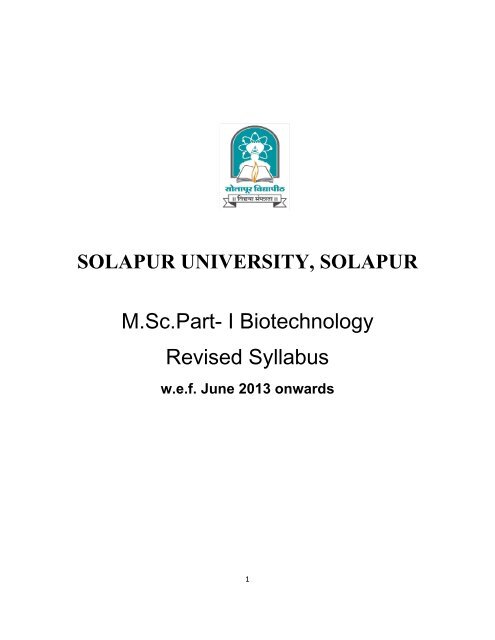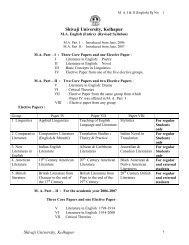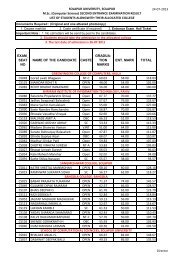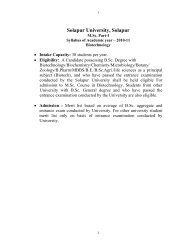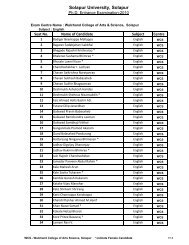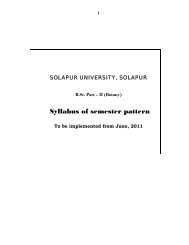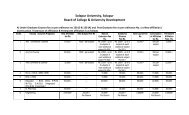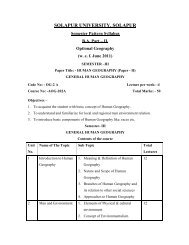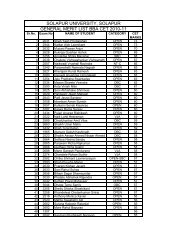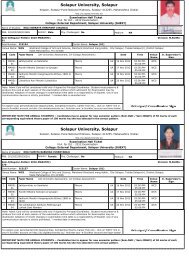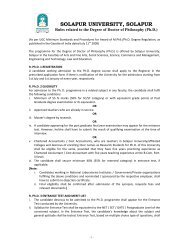M.Sc.Part- I Biotechnology Revised Syllabus - Solapur University
M.Sc.Part- I Biotechnology Revised Syllabus - Solapur University
M.Sc.Part- I Biotechnology Revised Syllabus - Solapur University
You also want an ePaper? Increase the reach of your titles
YUMPU automatically turns print PDFs into web optimized ePapers that Google loves.
SOLAPUR UNIVERSITY, SOLAPURM.<strong>Sc</strong>.<strong>Part</strong>- I <strong>Biotechnology</strong><strong>Revised</strong> <strong>Syllabus</strong>w.e.f. June 2013 onwards1
SOLAPUR UNIVERSITY, SOLAPUR<strong>Syllabus</strong> for M.<strong>Sc</strong>. I <strong>Biotechnology</strong><strong>Syllabus</strong> to be implemented from June 2013 onwardsSEMESTER‐ I (THEORY)Paper Title of the paper MarksMBT 101 Microbiology 100MBT 102 Biomolecules and Bioenergetics 100MBT 103 Inheritance biology 100MBT 104 Biostatistics and Bioinformatics 100PRACTICALSPractical Title of the practical MarksMBT 105 Biomolecules and Bioenergetics and Microbiology 100MBT 106 Inheritance biology and Biostatistics and Bioinformatics 100SEMESTER‐ II (THEORY)Paper Title of the paper MarksMBT 201 Cell Biology100MBT 202 Enzyme Technology 100MBT 203 Molecular Cell Processing 100MBT 204 Immunology and Immuno techniques 100Practical Title of the practical MarksMBT 205 Cell biology and Enzyme Technology 100MBT 206 Molecular Cell Processing and Immunology and Immune techniques 1002
<strong>Solapur</strong> <strong>University</strong>, <strong>Solapur</strong>M.<strong>Sc</strong>. I <strong>Biotechnology</strong>(<strong>Revised</strong> semester pattern syllabus)(w.e.f. June, 2013)1) Title of the Course: M.<strong>Sc</strong>.-I <strong>Biotechnology</strong> (<strong>Revised</strong> <strong>Syllabus</strong>) -2013-142) Introduction: This course provides a broad overview of biotechnology and to producesexpert hands that would have sufficient knowledge and expertise to solve the urgent problemsof the region by using biotechnology. The course structure is technology-centric wherestudents basically learn technology and are taught necessary basic subjects for that purpose.3) Objectives of the course:The objectives of M.<strong>Sc</strong>. <strong>Biotechnology</strong> course are• To provide an intensive and in-depth learning to the students in field ofbiotechnology.• Beyond simulating, learning, understanding the techniques, the course also addressesthe underlying recurring problems of disciplines in today scientific and changingbusiness world.• To develop awareness & knowledge of different organization requirement and subjectknowledge through varied subjects and training methodology in students.• To train the students to take up wide variety of roles like researchers, scientists,consultants, entrepreneurs, academicians, industry leaders and policy.4) Advantages of the Course:<strong>Biotechnology</strong> has tremendous job potential. The successful students will be able to establishtrading, industrial and consultancy organizations in pharmaceuticals, paper, fermentation,food processing & preservation, agriculture, environment protection and also their ownindustry for micropropagation of commercially important plants in vitro, transgenic plants,vaccine production, clinical pathology, genetic counseling, human karyotyping etc.• Multinational companies dealing with production of tissue cultured and geneticallymodified plants, food products, leather, dairy, beverages, pharmaceutical, chemicalIndustries, agribusiness, Environment protection.• Medical & <strong>Sc</strong>ientific Research Organizations.• Universities in India & aboard.3
5) Eligibility of Course:Eligibility: A Candidate possessing B.<strong>Sc</strong>. Degree with <strong>Biotechnology</strong> / Biochemistry/Chemistry/ Microbiology/ Botany/ Zoology/ B.Pharm/ MBBS/ B.E./ B.<strong>Sc</strong>.Agri./ life sciencesas a principal subject (Biotech), and who have passed the entrance examination conducted bythe <strong>Solapur</strong> <strong>University</strong> shall be held eligible for admission to B.<strong>Sc</strong>. Course in <strong>Biotechnology</strong>.Students from other <strong>University</strong> with B.<strong>Sc</strong>. General Degree and who have passed the entranceexamination conducted by the <strong>University</strong> are also eligible.• Admission: Merit list based on average of B.<strong>Sc</strong>. aggregate and entrance exam conducted by<strong>University</strong>. For other university student merit list only on basis of entrance examinationconducted by <strong>University</strong>.6) Duration:• The duration for this program is of 2 years with semester pattern(04 Semesters)7) Medium of Instruction: English8) Structure of the Course:• Structure of M.<strong>Sc</strong>. course in faculty of <strong>Sc</strong>ience has total of 04 semesters for 2 years.• M. <strong>Sc</strong>. I comprises of total two semesters. In each semester (I & II) four theory papers(Paper I & Paper IV) having weightage of 100 marks each.• For semester II comprises four theory papers (Paper V & Paper VIII) havingweightage of 100 marks each. Each paper comprising of 4 to 5 units distributed intotal 45 lecture hours.• Semester wise the practical examination is conducted which is based on theory papersI, II, III and IV. Total weightage of practical is100 marks.4
<strong>Syllabus</strong>:M. <strong>Sc</strong>. <strong>Biotechnology</strong> (Semester –I)MBT 101 Microbiology (45lectures)Unit I: Microbial Taxonomy 9History of Bergey’s Manual, Prokaryotic Domains, Taxonomic ranks, Traditional andModern methods of prokaryote Identification, General outline of Numerical and PolyphasicTaxonomy, Bacterial Nomenclature, Type Strain, Major Bacterial Culture collection units,Introduction to PHYLIP software.Unit II Microbial Diversity 9General characters of Oxygenic and Anoxygenic Photosynthetic microbes, Magnetogenicbacteria, Methanogenic archaebacteria.Unit III: Extremophiles 9General characters and examples of Extremophiles- acidophilic, alkalophilic, thermophilic,barophilic, osmophilic and halophilic.Unit IV: General Virology 9Classification of viruses, Isolation and Cultivation of Bacteriophages, Cultivation of Animalviruses by using- Egg inoculation, Tissue culture and Live animals, Enumeration of virusesby- Electron microscopy, Plaque method and End point method, Inhibition and inactivationof viruses by- photodynamic inactivation by physical and chemical agents, antiviralchemotherapeutics and Interferons.Unit V: Reproduction of Viruses 9One step growth curve experiment, Single burst and premature lysis experiment,Reproduction of Bacteriophages- Lytic cycle (T phage, phage θ-X 174), Lysogenic cycle (λ,P2, and Mu 1 phages), Replication of Animal viruses- ssRNA + stranded (Polio), ssRNA -stranded (Influenza), dsRNA(HIV), ssDNA(Parvo), dsDNA(Hepatitis B), Plant viruses-Vector and Nonvector based transmission, reproduction of TMV.References:1) Bergy’s Manual of Systemic Bacteriology.2) Brock Biology of Microorganisms – MF Madigan3) General Microbiology – Stanier et al.4) Microbiology – Pelczar JR.5) Microbial Genetics - Freifelder6) General Virology - Luria7) Introduction to Plant Virology – Bos I8) Animal Virology – Fenner, F and White, D.O.5
9) Virology – Dulbecco R. and Ginsberg H.S.10) Extremophiles – B. N. Johri11) Microbial Diversity – D. Colwd12) Microbial life in Extreme Environment – D.S. Kushner13) Microbial Ecology – J.M. Lynch and N.J. PooleMBT 102: Biomolecules and Bioenergetics (45lectures)UNIT II: MITOCHONDRIA 9Architecture, chemical activity of mitochondria. Sequence of electron carriers and sites ooxidative phosphorylation, ATP generation, heme and non- heme iron proteinsThermodynamic considerations, oxidation - reduction electrodes, standard electrode potentiaredox couples, phosphate group transfer potential. Respiratory controls. Theories of oxidativphosphorylation, uncouplers and inhibitors of energy transfer. ATP synthetase complexUNIT III:CHLOROPLAST 9Architecture, - light harvesting complexes, bacteriorhodopsin, plastocyanin, carotenoids another pigments. Hill reaction, photosystem I and II - location and mechanism of energtransfer, photophosphorylation and reduction of carbon dioxide. Calvin cycle, quantitativefficiency, photorespiration, C4 - metabolism. Chemiosmotic theory and evidence for itoccurrence, ion transport through membranes, proton circuit and electro-chemical gradienionophores, Q cycle and stoichiometry of Proton extrusion and uptake, P/O and H/P ratiosreverse electron transfer. Fractionation and reconstitution of respiratory chain complexes.UNIT IV: HORMONESGeneral classification of hormones - synthesis, structure, secretion, transport, metabolism anmechanism of action of pancreatic, thyroid, parathyroid, hypothalamus, pituitary, adrenal anprostaglandins. Hormonal control of spermatogenesis, menstrual cycle,Pregnancy and lactation. Cell membrane and intracellular receptors for hormones. Secondarmessengers Plant growth hormones - auxins, gibberllins, abscessic acid, cytokininsPhenoromonesUNIT V:NITROGEN FIXATION 9Biological fixation of nitrogen- symbiotic and non-symbiotic. Nitrogenase enzyme complexazoferredoxin and Molybdoferrodoxin. Physiological electron donors and mechanism onitrogen reduction, assimilation of ammonia, nitrogen cycle. nif genes and its regulatio(Klebsiella and Rhizobium).6
References:-1. Biochemistry by Lubert Stryer, 4 th Edition2. Biochemistry by Mathew VanHolde3. Lehningers Principles of Biochemistry by Nelson and Cox4. Hormones by Norman Litwack5. Basic and Clinical Endocrinology- Greenspan and Baster6. Biochemistry and Physiology of Plant Hormones- Thomas Moore7. Annual Review of Biochemistry 19778. Thermodynamics for Biological Systems -BaineMBT 103: Inheritance biology (45lectures)UNIT-I: Gene Concept, Mendelist and Extension of Mendelian Principles10A. Concept of Gene: Allele, Multiple Alleles, Pseudoallele, Complementation tests.B. Mendelian Principles: Dominance, Segregation, Independent Assortment,Deviation from Mendelian Inheritance.C. Extensions of Mendelian Principles: Codominance, Incomplete Dominance(<strong>Part</strong>ial Dominance), Gene Interactions, Pleiotrophy, Genomic Imprinting,Penetrance and Expressivity, Phenocopy, Linkage and Crossing over, Sexdetermination, Sex Differentiation, Sex Linkage, Sex limited and Sex influencedcharacters.UNIT- II: Mutation and Structural Alterations of Chromosome 10A. Mutation: Types, Causes and detection, Mutant types –lethal, Conditional,Biochemical, Loss of Function, Gain of Function, Germinal verses Somaticmutants, Insertional Mutagenesis (Transposon based –biological mutagens).B. Structural and Numerical alterations of Chromosome: Deletion, Duplication,Inverstion, Transloaction, Ploidy and their genetic implications.7
UNIT- III:Microbial GeneticsMethods of genetic transfers –Transformation, Conjugation, Transduction, sexduction,Mapping genes by interrupted mating, Fine structure analysis of genes –S Benzes work.UNIT- IV: Gene Mapping MethodsLinkage maps, Tetrad analysis, Mapping with molecular markers, Mapping by using somaticcell hybrids, development of mapping population in plants.UNIT- V: Extra Chromosomal InheritanceInheritance of mitochondrial and chloroplast genes, Maternal Inheritance, Plasmidinheritance.References:1. Principles of Genetics 8 th edition, Eldon J. Gardner, Michael J. Simmons, and D.Peter Snustad, Wiley India Edition (Indian edition).2. Molecular Genetics: An introductory Narrative (2 nd Edition) Gunther S. Stent andRichard Calendar, CBS Publishers and Distributors (Indian Edition) –Reprint2004.3. Principles of Genetics, 7 th Edition, Robert H Tamarin, Tata McGraw Hill Edition(Indian Edition) –Reprint 20044. Genetics 5 th edition –Strickberger, Pearsons publisher –Low Price Edition (IndianEdition).5. Modern Microbial Genetics –Editors Uldis N Streips and Ronald E. YasbinWiley –Liss publications, 1991.8
MBT 104: Biostatistics and Bioinformatics (45Lectures)UNIT I Basic terms, measures of central tendency and dispersion 13Population, Sample, sampling method, variable, parameter, classification of data, Frequencydistribution, tabulation, graphic and diagrammatic representation. Mean, median, mode,quartiles and percentiles, measures of dispersion: range, variance, standard deviation,coefficient of variation, symmetry: measures of skewness and kurtosisProbability and distributions:Definition of probability (frequency approach), independent events. conditional probability,Examples of Bernoulli, Binomial, Poisson and Normal distributions. Coefficient ofdistribution, Use of these distributions to describe in biological models.UNIT II Bivariate data 10<strong>Sc</strong>atter plot, correlation coefficient (r), properties (without proof), Interpretation of r, linearregression. Fitting of lines of regression, regression coefficient, coefficient of determination.HYPOTHESIS TESTING:Hypothesis, critical region, and error probabilities. Z-test, ‘t’-test, Chi-square test forindependence. P-value of the statistic. Confidence limits, Introduction to analysis of variance.UNIT III Introduction to bioinformatics 8Introduction to genomics and proteomics; NCBI; SRS.BIOLOGICAL DATABASES [Introductory only]:Nucleic acid sequence databases:- EMBL, DDBJ, GenBank; Primary Protein sequencedatabases:- PIR, MIPS, Swiss – PROT, TrEMBL, NRL–3D; Composite Protein sequencedatabases: - NRDB, OWL, MIPSx, SWISS-PROT + TrEMBL; Secondary Protein databases:- PROSITE, PRINTS, BLOCKS, PROFILES, Pfam, IDENTIFY; Structure classificationdatabases: - SCOP, CATH, PDBsum.; Structural Databases: - PDB, NDB, MMDB.UNIT IV Sequence analysis methods 6Methods, Algorithms, tools and applications of Pairwise sequence analysis and multiplesequence analysis.PHYLOGENETIC ANALYSIS:Elements of phylogeny, methods of phylogenetic analysis, Phylogenetic tree of life,phylogenetic analysis tools- Phylip, ClustalW.UNIT V Homology modeling 8Homology modeling, prediction of protein structure from sequences, Secondary structure,three-dimensional structure prediction, Validation of 3-D structure (Ramchandran plot).MOLECULAR MODELING:Introduction, molecular mechanics, force field, potential energy functions, energyminimization, single point calculations, full-geometry optimization, conformational search,docking, molecular dynamics simulations, molecular modeling packages.9
References:-1. Biostatistics : A foundation for Analysis in the Health <strong>Sc</strong>iences 7/E /Wayne W.Daniel, Wiley Series in Probability and Statistics.2. Introductory Statistics. Fifth Edition. (2004) Prem S. Mann John Wiley and Sons(ASIA) Pte Ltd.3. Basic Statistics-Aprimer for Biomedical <strong>Sc</strong>iences-(Olive Jean Dunn).4. Biostatistics-An introductory text – (Auram Gold Stein).5. Statistics : An Introductory Analysis (Taro Yamane) Harper and Row Publisher1964,67,736. Introduction to Bioinformatics, (Atwood, T. K. and Parry-Smith, D. J).7. An introduction to Computational Biochemistry. (C. Stain Tsai, A JohnWiley andSons, Inc., publications).8. Developing Bioinformatics Computer Skills. (Cynthia Gibas and Per Jambeck).9. Bioinformatics Methods and Applications Genomics, Proteomics and DrugDiscovery. (Rastogi S. C. Mendiratta, and Rastogi P.)10. NCBI Web site: http://www.ncbi.nlm.nih.gov10
PracticalsMBT 105: Biomolecules and Bioenergetics and Microbiology1. Isolation of chloroplast and evaluation of oxygen using Hill oxidant.2. Study of methyl viologen as a terminal electron acceptor.3. Study of respiration of mitochondria and oxidative phosphorylation.4. Effect of inhibitors on respiratory chain.5. Effect of uncouplers on oxidative phosphorylation.6. Isolation and determination of activity of nitrate reductase.7. Determination of relative strength of common redox reagents.8. Study of E. coli as type strain with respect to its morphological and biochemicalcharacters.9. Study of Clustal W tool for phylogenitic relationship among related species.10. Isolation of Acidophilic bacteria and study its morphological and biochemicalcharacters.11. Isolation of Alkalophilic bacteria and study its morphological and biochemicalcharacters.11. Isolation of Thermophilic bacteria and study its morphological and biochemicalcharacters.12. Isolation of Halophilic bacteria and study its morphological and biochemicalcharacters.13. Isolation and cultivation of Bacteriophages.14. Embryonated Chick egg technique.MBT 106: Inheritance Biology and Biostatistics and Bioinformatics1. Demonstration of Mendelian principles using Drosophila / plant system.2. Numerical exercises related to Mendelian principles, gene interactions, linkage andgene mapping.3. Studies on induction and detection of sex linked recessive lethals (Drosophila).4. Studies on mutagenic treatment to seeds, pollen grains and its mitotic and meioticanalysis.5. Study of mutation analysis in bacteria (antibiotic resistance).6. Study of transformation, conjugation and transduction.11
7. Study of construction of restriction map of plasmid DNA.8. Measures of Central Tendency and Dispersion on Excel9. Statistical Analysis using EXCEL (Diagrammatic and graphical presentation)10. Introduction to PubMed & PMC and retrieval of literature.11. Retrieval of an amino acid sequence, nucleotide sequence and performing BLASTand FASTA.12. Multiple sequence alignment by CLUSTALx/w (offline tool).13. Homology modelling for prediction of 3D structure & its visualization.14. Structure analysis: secondary, tertiary and Quaternary structure, bond angle, bondlength, different interactions by RasMol.15. Phylogenetic studies & construction of phylogenetic tree.16. Introduction to chimera.12
M. <strong>Sc</strong>. <strong>Biotechnology</strong> (Semester –II)MBT 201: Cell Biology (45lectures)UNIT I: Cell organelles: 8Cell Theory, Cell organization of prokaryotic and eukaryotic cells. Structural and functionalcapitalization of Cell organelles – mitochondria, chloroplast, Lysosomes, nucleus,Peroxisomes.UNIT II: Intracellular Protein trafficking 9Cytoplasmic Membrane: Chemical Composition of Membrane, Structure and function ofMembrane proteins, Fluid Mosaic Model, Movement of substances across cell membrane –Diffusion, Active transport.Membrane Trafficking: Vesicular transport from Endoplasmic reticulum to Golgi Apparatus,Endoplasmic reticulum and its function, Vesicular transport in Golgi apparatus. Golgicomplex and its function.UNIT III: Cytoskeleton 9Structure and functions of microtubules, microfilaments and intermediary filaments. Workingof Actin, Kinesin, Dynein and ATPase as motor protein. Actin and myosin in heart.UNIT IV: Cell cycle and Cell adhesion 9Cell Cycle: Cell Cycle Phases, mitosis and meiosis, Role of cyclins and Cdks, Cell cyclecheck points.Cell Adhesion - Extracellular matrix. Cell-cell interactions and cell matrix interaction.Desmosomes, Hemidesmosomes, Integrins, Selectins, Cadherins, Tight Junction, GapJunction.UNIT V: Cell signalling 10Extracellular Messengers & their receptors, G-protein- Coupled receptors their secondmessengers and signal transduction pathway- Regulation of Glucose levels, Protein TyrosineKinases-RTK- Dimerization, Protein Kinase activation, RTKs activates downstreamsignaling pathway, signaling by the insulin receptors (RTKs) , Calcium as an intracellularmessenger: IP3 and Voltage-Gated Ca2+ Channels, Calcium binding Protein(calmodulin) &its role in signaling Intrinsic pathway of Apoptosis; Light induced signal transduction (Planttransduction). General Pathways of Ras- MAP Kinase pathway, Hedgehog pathway,WNTsignalling pathway, Notch Pathway, Nf-κB Pathway.13
REFERENCES:1. Molecular Cell Biology, Lodish et al. <strong>Sc</strong>ientific American Books (1995)2. The World of the Cell Becker, W.M. et al. Benjamin Cummings (2004)3. Cell and Molecular Biology, Karp G, John Wiley and Sons. (1999).4. Molecular Biology of Cell, Alberts B et al. Garland Publishers, (2001)5. Lehninger Principle of Biochemistry, Nelson DL and Cox MM, Worth Publishers,(2000)6. Principles of cell and Molecular Biology, Kleinsmith LJ & Kish VM, Harper CollinsCollege Publishers (1995).MBT 202: Enzyme Technology(45 lectures)UNIT I: ENZYMES13Classification - IUB system, rationale, overview and specific examples. Characteristics ofenzymes, enzyme substrate complex. Concept of active centre, binding sites, stereospecificityand ES complex formation. Effect of temperature, pH and substrate concentration on reactionrate. Activation energy. Transition state theory.ENZYME CATALYSIS:Factors affecting catalytic efficiency - proximity and orientationeffects, distortion or strain, acid - base and nucleophilic catalysis. Methods for studying fastreactions. Chemical modification of enzymes. Isoenzymes, Ribozymes, Abzymes.UNIT II:ENZYME KINETICS07Michaelis - Menten Equation - form and derivation, steady state enzyme kinetics.Significance of Vmax and Km. Bisubstrate reactions. Graphical procedures in enzymology -advantages and disadvantages of alternate plotting. Enzyme inhibition - types of inhibitors -competitive, non-competitive and uncompetitive, their mode of action and experimentaldetermination. Enzyme activity, international units, specific activity, turnover number, endpoint kinetic assayUNIT III:STRUCTURE FUNCTION RELATIONS05Lysozyme, ribonuclease, trypsin, carboxypeptidase, phosphorylase, aspartatetranscarbamylase and Na - K ATPase.UNIT IV:ALLOSTERIC INTERACTIONS 10Allosteric sites, Modulators, Protein ligand binding including measurements, analysis ofbinding isotherms, cooperativity, Hill and <strong>Sc</strong>atchard plots and kinetics of allosteric enzymes.ENZYME REGULATION: Product inhibition, feedback control, enzyme induction andrepression and covalent modification. Allosteric regulation.14
UNIT V:ENGINEERING TECHNIQUES:10Metabolic engineering, enzyme engineering.IMMOBILIZED ENZYMES: Relative practical and economic advantage for industrial use,effect of partition on kinetics and performance with particular emphasis on charge andhydrophobicity (pH, temperature and Km). Various methods of immobilization - ionicbonding, adsorption, covalent bonding (based on R groups of amino acids),microencapsulation and gel entrapment. Immobilized multienzyme systems. Biosensors -glucose oxidase, cholesterol oxidase, urease and antibodies as biosensorsReferences: -1) Fundamentals of Enzymology- Price and Stevens2) Enzymes -Dixon and Webb3) Isoenzymes By D. W. Moss4) Immobilized Biocatalysts- W. Hartneir5) Selected papers Allosteric Regulation -M. Tokushige6) Enzymes: Biochemistry, <strong>Biotechnology</strong> and Clinical Chemistry, Trevor Palmer, (2004)7) Principles and Applications in Engineering Series: <strong>Biotechnology</strong> for BiomedicalEngineers - Martin L.Yarmush, CRC Press, Boca Raton London New York Washington,D.C.MBT 203: Molecular Cell Processing(45 lectures)UNIT I : DNA Repair Mechanisms 05Excison, Mismatch, SOS, Photoreactivation, Recombination repair, Eukaryotic repairMechanismsUNIT II : Recombination 05Recombination between heteroduplex, Holiday intermediate, Proteins involved inRecombination, Role of recA, recBCD pathway in E.coli, single strand assimilation inBacteria.UNIT III : DNA Replication 10Unit of Replication (Replicon : Bacterial, Eukaryotic and Extra chromosomal)Bacterial Replication is connected to cell cycle, Enzymes involved in replication (DNAPolymerases of E.coli and Eukaryotes) Replication origin and Replication fork, Fedility ofReplication.15
UNITIV : Transcription 15Prokaryotic transcription: RNA Polymerases, Sigma factor and specificity binding to DNA,Promoters and their consensus sequences , Initiation of transcription, Elongation oftranscription, Termination of transcription (Rho dependent ,Rho independent termination,Antitermination) RNA Editing, SplicingEukaryotic transcription: RNA Polymerases, types & subunits, Promoter elements for threepolymerases, Activators, Enhancers, Repressors. Elongation and Termination oftranscription. RNA editing, splicing, polyadenylation.UNITV: Translation 10Ribosome, formation of initiation complex, initiation factors and their regulation, elongationand elongation factors, termination, genetic code, aminoacylation of tRNA, tRNA identity,aminoacyl tRNA synthetase, translational proof-reading, translational inhibitors, posttranslational modification of proteins.References:1. Benjamin Lewin -Gene VI, Gene VII, Gene IX, Gene X Oxford <strong>University</strong> press2 David Friefieder -Essentials of Molecular Biology, Jones &Barlett publications3 J. Kendrew Encyclopedia of Molecular Biology Blackwell <strong>Sc</strong>ientific publications.4 Weaver Molecular Biology5 J.D.Watson, N.H.Hopkins ,J.W Roberts,et al Molecular Biology of the Gene,Benjamin Cummings publ.co.inc.,California6 J.Darnell. et al molecular biology of the cell(2nd edition) Garland Publishing Inc.7 Meyers R.A (ed)., Molecular biology and biotechnology.VCH publishers NY Inc.8 Alberts B et al Molecular biology of the cell. Garland Publishing Inc.9 Watson J.D., Recombinant DNA.10 Malacimski; Essentials of Molecular Biology.11 Stansfield; Molecular and cell biology.12 Walker Molecular biology and <strong>Biotechnology</strong>.13 Brown T.A Essential of Molecular biology Vol 1 and 2 each.14 Dale Molecular Genetics of Bacteria16
MBT 204: Immunology and Immune techniques (45lectures)Unit I: Immunity 09Innate immunity- 1 st and 2 nd line of Defense, Humoral immunity- Clonal selection theory,Primary and Secondary immune response, Mechanism of antibody production against TI andTD antigens, Structures of Antibodies, Gene expression and Ig Diversity, Cell-Mediatedimmunity- lysis of Self-altered cells, Lytic pathways of CMI. Components of Humoralimmunity and CMI.Unit II: Antigen, MHC, Complement and Cytokines 09Antigen- Types, Factors affecting antigenecity, Epitopes, Haptens, Adjuvants, Mitogens,MHC- Genetic organization and inheritance, Antigen processing and presentation (Cytosolicand Endocytic pathway), Presentation of non-peptide antigens, Complements- Complementactivation pathways, Cytokines- Cytokines secreted by TH1 and TH2 cells and its regulation.Unit III: Medical Microbiology 09General information, structure/morphological and cultural characters, Life cycle,pathogenicity, and Laboratory Diagnosis of Bacterial Diseases (C. diphtheria, Cl. tetani, M.tuberculosis, S. typhi), Viral Diseases (Rabies, Influenza, HIV), Fungi (Candidiasis),Protozoan (Plasmodium malaria).Unit IV: Clinical Immunology 09Hypersensitivity: types and general mechanism of hypersensitivity) Autoimmunity: generalmechanism, (organ specific, non-organ specific). Transplantation immunology- ImmunologicBasics of Graft rejection, Immunosuppressive Therapy, Tumor immunology- Tumorantigens, Immune response to tumor antigens, Tumor evasion of the immune system, Cancerimmunotherapy.Unit V: Antigen-Antibody Interactions and Vaccines 09Antigen-antibody interactions: Principles, applications, strength, cross-reactivity, features ofinteractions, precipitation, immunodiffussion, Immunoelectrophoresis, agglutination,complement fixation test, immunofluorescence test, Radioimmunoassay, ELISA, Flowcytometry with fluorescence. Genetically Engineered Vaccines- Subunit vaccines (Herpessimplex, SARS, S. aureus), Peptide vaccines (Foot and Mouth disease, Malaria), DNAvaccines (Dental caries), Attenuated vaccines (Cholera, Salmonella, Leishmania), Vectorvaccines17
References:1. Immunology - Kuby2. Essential Immunology- Roitt3. Cellular and Molecular Immunology- Abbas4. Immunology and Serology- Philip Carpenter5. Textbook of Immunology- Barrette J.T.6. Basic and Clinical Immunology- Fundenberg H.7. Biology of Immune response- Abramoff and Lavice8. Fundamental Immunology 5th edition (August 2003): by William E., Md. Paul9. Immunology an Introduction- Tizard10.Molecular <strong>Biotechnology</strong>-Principles and applicatons of rDNA- 4 thBernard R. Glich et al.Edition,11. Textbook of Microbiology- Ananthanarayan and Paniker12. Microbiology 5 th Edition- Prescott13. Microbiology – Pelczar JR.14. Microbial Genetics - Freifelder15. Brock Biology of Microorganisms – MF Madigan16. General Microbiology – Stanier et al.17. General Virology - Luria18. Animal Virology – Fenner, F and White, D.O.19. Virology – Dulbecco R. and Ginsberg H.S.20. Medical Microbiology- Fritz H. Kayse18
PracticalsMBT 205 :Cell Biology and Enzyme technology1. To isolate and study Animal cell (human), Plant cell, Bacteria, and Fungi under a microscopeand prepare a comparative table.2. To study all the phases of Mitosis and Meiosis in a cell3. To study Permeable and Semi-permeable membrane of cell using the concept of Osmosis4. To investigate the effect of Heat/Enzymes/Chemicals on the permeability of plant cellmembranes5. Study of chloroplasta. Observe chloroplast under microscopeb. Isolation of Chloroplast6. Study of Mitochondriaa. To observe Mitochondria under microscopeb. Isolation of Mitochondria7. To observe red blood cells and white blood cells.8. To study the Cell proliferation/Cell viability using MTT.9. Visit to nearest Hospital to study flow cytometer (FACS)10. Isolation and quantification of activity of – amylase / invertase / alkaline phosphatase(salivary / plant source)11. Determination of specific activity of enzyme.12. Determination of activity of enzyme in presence of activator and inhibitor.13. Determination of Km and Vmax of Invertase.14. Determination of optimum parameter of enzyme – pH and temperature.15. Induction and estimation of beta- galactosidase.16. Immobilization of enzyme.19
MBT 206: Molecular cell processing and Immunology and Immunetechniques1. Effect of protein synthesis inhibitors on the induction of beta galactosidase.2. To study the phtoreactivaton in bacteria3. Isolation of bacterial DNA.4. Isolation plasmid DNA.5. Isolation of DNA from yeast.6. Isolation of RNA from Plant cell / yeast.7. Silver nitrate staining of DNA.8. Isolation of organelle DNA (Chloroplast / mitochondria)9. Collection of blood separation of plasma and serum and its preservation.10.Study of slide agglutination test by colony emulsion method for the diagnosis ofSalmonella typhi.15. Isolation of Salmonella typhi and study of its morphological and biochemicalCharacters.12. Diagnosis of Salmonella typhi by Widal test (Qualitative and Quantitative test)13. Isolation of Candida species and study its morphological characters (Budding,Mycelia, Spores).14. To study the Dot-blot ELISA.15. Demonstration of ELISA for HIV diagnosis.20


